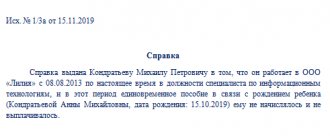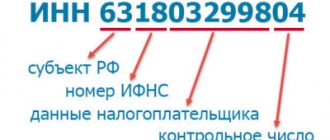Home / Risks
Back
Published: 01/14/2020
Reading time: 8 min
0
48
- 1 Why?
- 2 Procedure for conducting DNA research
- 3 How much does a DNA test cost, and who pays for it?
- 4 Procedure for collecting material and drawing up a protocol
Purpose of genetic testing
In most cases, to establish paternity, written evidence, testimony and photographs confirming the cohabitation of a man and woman during the alleged period of conception of the child are sufficient. If there are not enough of them, at the request of the party, a genetic DNA paternity examination is ordered, the purpose of which is to establish the fact of the relationship between the father and the child.
If DNA testing shows that the man is the biological father, the court will decide to establish paternity, even if he denies it.
A woman gets the opportunity:
- collect child support;
- determine the place of residence of the son or daughter, establish the procedure for communication with the father;
- Based on proven paternity, the child will be able to claim the father’s inheritance in the event of death.
Important! If a child was born not in an official marriage, but while living together, the father is established only when the mother and father submit an application to the registry office. Otherwise, the documents indicate the patronymic name given by the mother, and a dash is placed in the “father” column.
In the absence of a confirmed relationship, the woman will not seek child support, because officially his biological father is no one.
The results of the DNA examination fundamentally confirm the relationship between the man and the child; on their basis, the court makes a decision and appropriate entries are made in the registration documents of the minor.
Why?
Typically, DNA genetic testing is prescribed to determine biological relationships. The grounds for its implementation may be different: challenging paternity, receiving inherited property, collecting alimony payments from a possible father, etc.
If doubt arises that a man is the child’s father, a special examination can be carried out. This procedure is carried out in a specialized laboratory that has passed the appropriate accreditation and has a license to conduct this type of activity.
It should be noted that the results obtained cannot serve as recognition of paternity. Establishing such a fact is the exclusive prerogative of the judicial authority.
The initiators of establishing the fact of paternity can be:
- Potential father;
- Citizen included in the baby's birth certificate;
- Mother of a child, in a situation where a man refuses such a relationship;
- The child can independently upon reaching the age of 18 years.
Cost of DNA paternity test
Prices depend on the specific type of analysis and the pricing policy of the institution.
Table “Approximate cost of DNA test services”
| Service name | Deadline for receiving results | Cost, rub.) |
| Standard DNA testing | From 3 days | 5 000-6 000 |
| Non-invasive testing during pregnancy | From 10 to 20 days | From 35 000 |
| Express test | 8-10 hours | From 10 000 |
| Analysis for the court | 3-5 days | From 8 000 |
| Test for pre-trial paternity determination |
Note! The above prices are only approximate prices. Final prices should be obtained from the clinics. Expertise during legal proceedings will be cheaper.
Who pays for the examination?
According to Art. 96 of the Code of Civil Procedure of the Russian Federation, the analysis is paid for by the party that filed a request for its conduct. This money is recovered from the defendant after winning the case as compensation for legal expenses. When both parties need an examination, the costs are paid by the plaintiff.
If the decision to conduct a DNA test is made jointly by the parents in pre-trial proceedings, they independently decide who pays for it.
Based on Part 2 of Art. 96 of the Code of Civil Procedure of the Russian Federation, genetic examination can be paid for from the federal budget if it is appointed by a judge. However, this rule does not apply to DNA testing.
The examination is paid for from the federal budget when an expert decision is needed by the court. And to establish paternity, the plaintiff must independently prove the existence of a family relationship. The examination is not the most important evidence and is considered on an equal basis with the entire evidence base.
How to challenge paternity in court?
Claim to challenge paternity
Ordering a genetic examination in court: step-by-step instructions
A request to order an analysis may be made in a statement of claim or at any stage of the legal proceedings before a decision is made.
The procedure for ordering a genetic examination:
- The plaintiff submits an application to establish paternity to the court, and a hearing is scheduled.
- If the petition was not stated in the claim, but the evidence presented is insufficient to determine the biological relationship, it is sent by the plaintiff or the defendant. If the request is granted, a determination is made to order an examination.
- Parents and the child are sent to an expert center, where biological material is collected.
- When ready, the results are handed over to the production party or sent to court.
- At the re-hearing, the court considers the expert opinion. On its basis, a decision is made to recognize the man as the father of the child if there is sufficient other evidence. It can be challenged within 30 days, after which it comes into force.
Before a decision is made, the recognized father has the right to send a counter-petition to schedule a re-examination in another institution. If the court is satisfied, the analysis is carried out again, and the results are considered at the next meeting.
If a repeated study conducted by a man indicates that he is not biologically related, the decision to recognize paternity is challenged through the appellate authority. If the complaint is satisfied, the case is sent for re-examination in a lower court.
Contents and form of a request to appoint an examination
According to Art. 35 of the Code of Civil Procedure of the Russian Federation, the parties to the proceedings have the right at any stage to file a petition for the appointment of a genetic examination.
It should contain information:
- name and address of the court where it is filed;
- Full name, residential address of the plaintiff and defendant;
- number of the case under consideration;
- circumstances that gave rise to the filing of the petition: for example, the defendant’s objection to recognizing paternity, insufficiency of evidence;
- essence: a petition to appoint an examination to determine the relationship between the defendant and the child (full name, date of birth);
- a list of submitted documents (copy of the application);
- date of compilation and signature of the initiator.
Important! The refusal to satisfy the petition is contested through the appellate authority.
Are you tired of reading? We’ll tell you over the phone and answer your questions.
Procedure for conducting DNA research
When preparing a case to establish paternity for a court hearing and during the proceedings, the court has the right, taking into account the opinions of the parties involved and the circumstances of the case, to decide to order an examination. Her conclusion about the origin of the child, taking into account the results of the test conducted using the “genetic fingerprinting” method, is considered one of the evidence in the case and must be assessed by the judge in conjunction with other materials.
In a situation where a DNA test confirms paternity, the court's decision will establish the child's origin from the father. The party in whose favor the decision is made is awarded compensation from the defendant for all legal expenses incurred. That is, if the examination was carried out at the request of the plaintiff, for example, the mother, and she paid for the test, then all her expenses should be compensated by the father, but on the condition that the examination confirms his blood relationship with the child.
If the claim is partially satisfied, costs may be awarded in proportion to the amount of claims satisfied by the court, and to the other party, accordingly, in proportion to the share of claims that were denied to the applicant.
The appropriateness of the test and its purpose is determined by the judge considering disputes about establishing or challenging paternity, at the request of one or more parties.
By law, judges do not have the right to initiate genetic research or force participants in the process to conduct it if there is no voluntary consent to this. Even in a situation where DNA tests are the only way to establish a family connection between people.
But at the same time, in judicial practice there are often cases when a citizen’s evasion from participation in a molecular genetic study appointed for the judicial establishment of kinship with a child is regarded as an opportunity to recognize paternity as established in court.
The interested party's petition must contain a question that needs to be raised to identify laboratory specialists, as well as identify the person paying for the research. It is important that the specific formulation of the task set for the resolution of specialists is important; questions must be posed unambiguously in order to exclude their unreliable interpretation. There may be different possible presentations of possible conclusions that may play a role in the outcome of the trial.
The following questions may be asked for permission from specialists:
- Does the material taken for research belong to a specific person;
- Based on the test results, whether one of the parties is the biological father of a particular child;
- The plaintiff or defendant is the mother of the child;
- A woman becomes pregnant due to a specific man.
The obligation to pay for the examination rests with the person who filed the application to conduct it. If the party to the proceeding who is charged with paying for the tests evades compensation, the expert institution issues an invoice, the amount of which is taken into account by the court when distributing costs between the parties to the proceeding.
An application for a genetic test must contain the circumstances presented by the interested person that require confirmation through such an examination, as well as an argument for the possibility of obtaining the required information to confirm the biological relationship of the father and child by obtaining a specialist opinion.
To carry out a genetic test, both father and child will need to take a blood test.
In some cases, material is also taken from the mother. In order for the results obtained to have legal force in judicial proceedings, all activities must be carried out in full compliance with the requirements of current legislation and comply with the following procedure:
- Interested persons providing biomaterial for research must contact the organization conducting the examination, providing a passport and birth certificate of the child.
- Blood sampling from study participants is carried out in the presence of witnesses.
- Laboratory assistants seal envelopes with tests and send them to the medical laboratory.
- The results of the forensic medical examination of molecular genetic material are sent directly to the judicial authority. They must accurately, without various assumptions, make it possible to determine the possibility of paternity of a particular person in relation to a particular child, and if a relationship is not excluded, then what is the probability that the information obtained is not the result of a random identity of individual characteristics of non-relative people.
We invite you to familiarize yourself with How to withdraw company money: one legal method and four dangerous ones - Modulbank Case
It should be noted that in accordance with established medical standards, the degree of evidence of the examination of the fact of biological relationship must reach a certain level. For example, the laboratory has the right to make a conclusion about the indisputability of the paternity of a particular person if the DNA of the father and the baby matches:
- At least 99.90% when the analysis was taken from three people - mother, child and potential father;
- More than 99.75% if the biomaterial was provided by the father and child.
The provisions of procedural law allow for additional research if the prepared conclusion does not clearly answer the questions posed.
In addition, the court may order a re-examination when doubts arise about the reliability and validity of the data or contradictions in the information are identified. But the activity of a judge is limited by the legislative deadlines for conducting legal proceedings, and therefore a re-examination is ordered only in individual cases.
There are cases when one of the participants in a DNA test refuses to voluntarily provide biological material for an examination to establish paternity.
In order to get out of this situation, the party initiating it must file a claim in court. In this application it is necessary to indicate the passport details of the plaintiff, the defendant and the child himself.
The following must be attached to the claim:
- a certified copy of the child’s birth certificate;
- a list of evidence of cohabitation between the plaintiff and the defendant (copy of correspondence, joint photographs and videos, certificates from medical institutions, witness statements, etc.).
After providing the court with all the necessary documents, a court date is set within five days, at which a petition to order a DNA examination is accepted. The institution in which it will be carried out is chosen by the plaintiff independently.
However, it is impossible to force a parent to undergo an examination, since according to the law, the parent has the right to refuse to undergo it. In this case, when establishing relationship, the court relies on previously provided indirect evidence.
In order for the court decision to recognize paternity to come into force, you must contact the registry office, providing a passport, birth certificate, a document confirming payment of the state fee, and the court decision itself.
Expert opinion
Irina Vasilyeva
Civil law expert
Please note that according to current legal regulations, payment for the DNA test is borne in full by the plaintiff. However, if the fact of paternity was confirmed by an examination, the plaintiff has the right to receive one hundred percent compensation for its cost. To do this, you need to apply to the court for compensation of its cost.
Like any genetic study, establishing paternity requires DNA samples. Biological materials are provided by the potential father, or fathers, if there are many applicants for paternity and a child.
Paternity testing can be done anonymously, without the knowledge of the father and the child. This does not require their permission or the mother's permission. For example, a father’s mother can collect cigarette butts or hair from him, nails from a child and take them to a DNA laboratory. You can indicate fictitious names or designate them with any other letters and numbers for conspiracy. Geneticists will conduct a test and issue a conclusion. True, such a conclusion will not have legal force, but peace and tranquility in the family will be restored.
For judicial or other authorities, a special procedure is required. If the regulations are fully complied with and all requirements are met, then the court will definitely accept such a conclusion to determine paternity.
“How many people, so many opinions.”
However, in order not to traumatize the child, or if the goals of mom and dad coincide, a paternity test can be done voluntarily. This test is also called a pretrial paternity test. It can be carried out if a petition has not yet been filed with the court and the judge has not ordered a specific DNA laboratory to conduct the study.
Documents that need to be provided:
- Original passport of the alleged father. If the father is a citizen of another state, then a foreign passport;
- The original passport of the child, if the child has reached 18 years of age. If the child is a minor, then the original birth certificate of the child is provided. If the child is a citizen of a foreign country. Then a document is provided that was issued to the child at his birth in the country of birth;
- If the father is not the official parent, then the mother must be present as the official parent. The mother also needs an original passport;
- If a minor child does not have official parents, then the presence of an official guardian is mandatory. The guardian is required to provide the original passport and the original document confirming guardianship.
If you do not have the original passport or birth certificate, you can provide a notarized copy of the document. If there is no notarized copy, then it is possible to provide a photocopy or other certificate. But the protocol will reflect that the identification was carried out using a photocopy or certificate. The judge will take this information into account and the decision to make such a conclusion will be solely on the judge’s side.
How the examination is carried out: description
Genetic testing can be carried out in any medical institution with the appropriate license.
DNA test procedure:
- Mother and child go to a medical facility where a test is taken. Biomaterials are usually used from the mucous membranes: the expert takes them by running sterile cotton swabs along the inner surfaces of the cheeks of a man and a child.
- The materials are sent for research. When the results are ready, the parties receive forms containing information about the participants. When confirmed, the relationship is indicated in the document as a percentage (approximately 95-99%). There is no rounding to 100% because it may be that the man being studied has a twin brother who has an identical set of genes. Such cases are 1 in a million, but they do happen.
- The results obtained are sent to the court, and a decision is made on their basis.
Methods of conducting research
Usually, for analysis, epithelial particles are collected from the inner surfaces of the cheeks of the subjects being studied - a potential father and child. Experts may take blood, skin particles or other biomaterials.
If it is necessary to establish paternity during pregnancy, from 9-10 weeks you can use a non-invasive method: a specialist takes blood from the mother, then the plasma is separated in the laboratory, and the DNA of the fetus itself is isolated. There is no point in conducting analysis before the specified period: there is a possibility that the results will be incorrect.
What is needed to take the test?
To carry out the analysis, parents just need to bring with them:
- passports,
- court ruling ordering an examination,
- documents for the child.
If he is under 14 years old, he will need a birth certificate, or more - an identity card.
Currently, DNA testing is carried out by taking material with cotton swabs from the mucous membranes of the cheeks, but hair, blood and other biomaterials can be used. There is no need to take them yourself: everything is done in a laboratory under the supervision of a specialist.
Timing of the examination
The timing depends on the specific technique. On average, the conclusion is issued within 5-10 days.
Anonymous examination
The alleged father can contact the medical center for an anonymous analysis. The results and other documents contain minimal information about the participants; the procedure is carried out without the knowledge of the mother and child.
You can visit an institution providing such a service yourself, taking only hair with roots or other available biomaterial from the child and providing yours.
Due to anonymity, the results of such an examination cannot be added to the case file, but failure to confirm paternity will become grounds for challenge.
Challenging the examination in court
If you do not agree with the expert opinion, you have the right to submit a request to have the analysis repeated at another institution. During the study, different biomaterials are taken: if the disputed examination was done on saliva, then the next one will be carried out on blood.
If the court rejects the petition, you will have to challenge the refusal through a higher authority.
Application form
A request to order a re-examination must contain the following information:
- address and name of the court;
- case number;
- information about the participants in the proceedings: full name, passport details, addresses;
- details of the previously obtained expert opinion, results;
- a request to order a repeat study with or without indicating a specific organization;
- inventory of documents, date and signature.
Lawyer's answers to questions about genetic testing to establish paternity
Is it possible to conduct an examination to establish paternity if the mother is against it?
No, but in this case, on the basis of Art. 79 of the Code of Civil Procedure of the Russian Federation, the court will consider that she has something to hide, and the decision will most likely be made not in her favor.
Is it possible to conduct a DNA examination after the death of the child's father?
Yes. For this purpose, biological samples of the deceased person (if available) or materials from close relatives are taken. The study is carried out using specially selected markers that make it possible to determine kinship. The accuracy of the test is close to 99%.
Is it possible to test DNA for paternity at home?
You have the right to independently take biomaterials at home and send them for research, but the conclusion will not have legal force. The collection of materials should only be carried out by a specialist so that the examination can be used for legal proceedings.
What material is needed to establish paternity?
Usually, sampling is done from the mucous membranes of the cheeks (inner surfaces). Blood, hair, nails, etc. are also taken.
Is it possible to obtain DNA for free through the court?
Yes, if the research is carried out on the initiative of the court, or the initiator has a poor financial situation, and the court considers it necessary to finance the analysis from the budget. An appropriate determination will be made regarding this.
How much does a DNA test cost and who pays for it?
In addition to a specialized laboratory in Moscow, what else is needed for a DNA paternity test? Research is carried out:
- on the initiative of a woman or a man;
- by order of a child who has reached the age of majority;
- by decision of the court.
We suggest you read: If the employer does not give the work book, what to do: act, application, compensation, where to apply
In any case, the study must be carried out on a voluntary basis, even if it is ordered by a court order. This is a requirement. Now let’s find out what material is needed for a DNA paternity test and how it is collected.
To carry out the analysis, samples of biological material from the child and the alleged biological parent are required. Bioassays from the mother can also be used, this is especially true in cases where another close relative may be the parent. We also draw your attention to the fact that this analysis allows you to conduct a paternity test before the birth of the child.
Almost always, buccal epithelial cells are taken for analysis. To do this, a smear is made on the buccal mucosa of all persons participating in the procedure. The manipulation lasts from 3 to 5 minutes and does not cause discomfort. If you follow the instructions, you can do this yourself. In this case, you will need cotton swabs and a clean envelope.
A new pack of sticks should be used to take a smear. Before the procedure, you must rinse your mouth with clean water. Gently take the stick by one end and, pressing it tightly to your cheek and twisting it slightly, make twenty movements up and down. After this, cut off the end that was in your hand, and place the part with the head in an envelope, having first written the person’s personal data on it.
The envelope is then sealed using an adhesive strip. It is strictly forbidden to lick it or touch the inner surface with your hands. Also, samples should not be additionally placed in a plastic bag.
If you were wondering whether the price of a DNA paternity test in Moscow varies depending on the sample being analyzed, then the answer is “No”. But it’s best to use a special free set of cotton swabs and a special envelope. You can find out how you can get it from our consultants in Moscow or by phone.
If it is not possible to use epithelial cells, then other samples are taken for analysis. In such circumstances, to donate DNA for paternity, you need to take a few hairs with roots, nail clippings, dried blood stains or personal hygiene items from which DNA fragments can be extracted.
The DTL DNA laboratory conducts genetic research using standard and non-standard samples. We guarantee short deadlines, competitive prices and the most accurate results.
A DNA test is an analysis that can confirm the fact of relationship with almost one hundred percent accuracy or completely refute it.
It makes sense to carry out genetic analysis if:
- there is a need to confirm (or establish paternity) to award alimony payments or if a man has doubts about his relationship with the child;
- it is necessary to establish the degree of relationship between persons supposedly related to confirm the rights to receive an inheritance;
- to confirm close relationship between brothers and sisters;
- to establish or confirm cousin relationships;
- to determine the identity of the dead;
- to confirm identity (if necessary).
A genetic test is possible at any age. This requires the collection of certain genetic material (blood, epithelial tissue of the oral cavity, skin, hair with preserved bulbs, nail plates, saliva and other types of biological fluids containing living body cells).
DNA analysis can be carried out by certified public or private scientific laboratories. In almost all cases (with the possible exception of identifications or those carried out at the request of law enforcement agencies), this procedure is paid. The cost of a DNA test ranges from seven to one hundred thousand rubles, and sometimes even higher.
The cost of the procedure depends on:
- number of test participants;
- type of biological sample being analyzed;
- urgency of the procedure;
- pricing policy of the institution conducting the examination.
We invite you to familiarize yourself with what documents are needed for maternity capital
If the DNA text is carried out at the request of any of the parties, then the costs of its implementation are fully borne by the party initiating the analysis. If the test is carried out for medical reasons, it is paid for by the patient. If the test is carried out to establish paternity and, by court decision, the payment is made by the party - the applicant.
In some cases, payment for a DNA test may be included in the cost of health insurance or paid for by charitable foundations.
When considering cases of paternity, its establishment or challenge, the judge accepts any evidence presented by the parties to the dispute. But in practice, without reliable results of genetic research, it is quite difficult to determine the actual father of the child. Consequently, courts issue negative verdicts without such evidence, often guided only by the interests of the child.
Therefore, genetic studies are popular when defending the right to establish paternity or challenging it, regardless of their high cost.
The average cost of such analyzes can reach 20 thousand rubles.
The document is a multi-page document. Each page of the document is stitched and secured with a special tie or thread. The issuance of a conclusion depends on the number of test participants. Typically the lead time is 5-7 business days. There is also a forensic express test, here the results can be obtained after 2-3 days. The document must contain:
- All photographs of study participants and caregivers who were present at sample collection;
- All documents of participants and guardians;
- Indications of the instruments on which the analysis was carried out;
- A set of terms and their explanation;
- Conclusions of a genetic expert on the results of the examination. These conclusions must be confirmed by the signature of the geneticist and the seal of the laboratory.
The forensic genetic report is usually sent immediately to the address of the court where the trial will be held. However, you can get it in your hands. If you choose the second option, be sure to inform the specialist who takes the samples that you want to personally pick up the conclusion.










